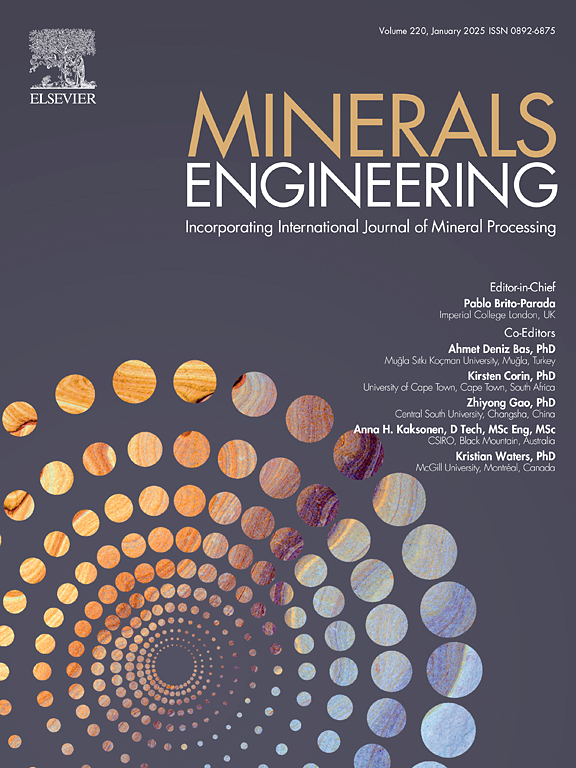铜离子在改善黄铜矿低温浮选中的作用
IF 4.9
2区 工程技术
Q1 ENGINEERING, CHEMICAL
引用次数: 0
摘要
提高硫化铜矿物在低温下的浮选性能具有重要意义。本研究系统研究了黄铜矿浮选性能的还原机理以及铜离子在改善黄铜矿低温浮选中的作用。浮选试验结果证明,低温下(5℃)黄铜矿的浮选回收率低于常温下(20℃),这与黄铜矿表面疏水性的变化有直接关系。然而,铜离子的加入可以有效改善黄铜矿在低温下的浮选。电化学测量表明,铜离子对低温下黄铜矿表面的氧化还原反应和电子传输有积极影响,从而提高了黄铜矿的电流密度和表面活性。此外,X 射线光电子能谱分析和吸附测量清楚地表明,铜离子主要以化学吸附的方式以 CuS 的形式吸附在黄铜矿表面,从而显著提高了黄原酸盐在黄铜矿表面的吸附量,改善了黄铜矿在低温下的浮选效果。本文章由计算机程序翻译,如有差异,请以英文原文为准。
The role of copper ions in improving the flotation of chalcopyrite at low temperatures
It is of great significance to improve the flotation of copper sulfide minerals at low temperatures. In this study, the reduction mechanism of chalcopyrite flotation performance and the role of copper ions in improving the flotation of chalcopyrite at low temperatures were systematically investigated. The results of the flotation tests prove that the chalcopyrite flotation recovery is lower at low temperatures (5℃) than at room temperatures (20℃), which is directly related to the changes in the surface hydrophobicity. However, the addition of copper ions can effectively improve the chalcopyrite flotation at low temperatures. Electrochemical measurements indicate that copper ions positively affect the redox reaction and electron transport on the chalcopyrite surface at low temperatures, thereby increasing the current density and surface activity of chalcopyrite. Besides, X-ray photoelectron spectroscopy analysis and adsorption measurements clearly indicate that copper ions mainly adsorbed on chalcopyrite surface in the form of CuS species by chemisorption, thereby significantly enhancing the adsorption amounts of xanthate on the chalcopyrite surface and improving the flotation of chalcopyrite at low temperatures.
求助全文
通过发布文献求助,成功后即可免费获取论文全文。
去求助
来源期刊

Minerals Engineering
工程技术-工程:化工
CiteScore
8.70
自引率
18.80%
发文量
519
审稿时长
81 days
期刊介绍:
The purpose of the journal is to provide for the rapid publication of topical papers featuring the latest developments in the allied fields of mineral processing and extractive metallurgy. Its wide ranging coverage of research and practical (operating) topics includes physical separation methods, such as comminution, flotation concentration and dewatering, chemical methods such as bio-, hydro-, and electro-metallurgy, analytical techniques, process control, simulation and instrumentation, and mineralogical aspects of processing. Environmental issues, particularly those pertaining to sustainable development, will also be strongly covered.
 求助内容:
求助内容: 应助结果提醒方式:
应助结果提醒方式:


